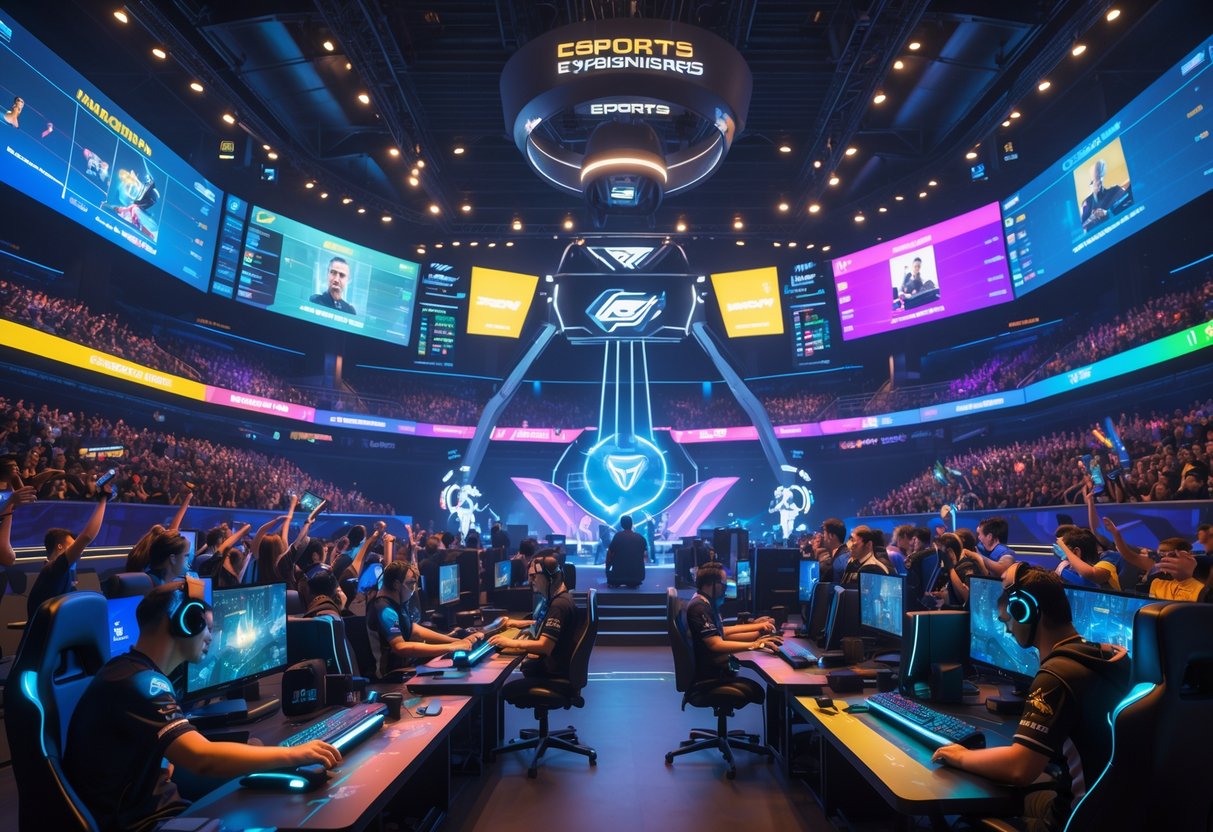Esports Bubble Discussion: Exploring the Boom and Its Consequences
Updated On: November 20, 2025 by Aaron Connolly
Understanding the Esports Bubble
An economic bubble pops up when people drive asset prices way beyond their real value. Speculation, not actual worth, fuels this rise.
In esports, you see this through massive investments in teams and leagues that just can’t generate enough revenue. This leads to shaky, unsustainable business models.
Definition of an Economic Bubble
An economic bubble forms when asset prices shoot up past what they’re actually worth. Investors get swept up in hype, tossing money in without much proof of profit.
The bubble balloons as more people jump in. Everyone thinks prices will keep climbing forever. But eventually, reality hits and the bubble bursts.
Typical bubble warning signs:
- Asset prices don’t line up with real earnings
- Wild speculation and lots of media buzz
- New investors pile in, often clueless about the risks
- Companies keep losing money but still rake in big investments
Remember the dot-com bubble in the early 2000s? Internet companies with zero profits landed millions because investors thought the future would magically fix everything.
When money pours into an industry faster than actual revenue grows, it’s a red flag.
How a Bubble Manifests in Esports
The esports bubble checks all the classic boxes. Team franchise fees hit £30-50 million, but most orgs run at a loss.
After franchising, player salaries soared from £75,000 to £230,000 on average in major leagues. Teams still can’t bring in enough to pay those bills.
Current bubble indicators:
- 89% of teams lose money, say industry analysts
- Viewership stats get inflated or compared in weird ways
- Investors treat esports like it’s the next NFL, but the business models aren’t proven
- Plenty of orgs have shut down or laid off staff lately
Frank Fields from Corsair didn’t mince words; he called it “almost a Ponzi scheme.” Teams burn through investor money while scrambling for sustainable revenue streams.
The franchise model limits team slots, creating artificial scarcity. This drives up prices, but it doesn’t guarantee the business will actually work long-term.
Historical Comparisons to Other Bubbles
Esports already went through one big bubble pop. Back in 2007, the Championship Gaming Series got £36 million from News Corp.
Players made £1,800 a month plus housing. Commentators landed £215,000 salaries. The whole thing collapsed in 2008 during the financial crisis.
Dot-com bubble similarities:
- Huge investments based on dreams, not profits
- Companies chasing growth, ignoring losses
- Inflated user numbers everywhere
- Investor hopes just didn’t match reality
Today’s esports bubble looks a lot like the dot-com era. Twitter lost money for 12 years, and Uber bled £3.2 billion a year before going public.
But esports faces its own hurdles. Game publishers own the IP and can shut down leagues anytime. Traditional sports took decades to build stable revenue streams.
Unlike the internet, which is everywhere, esports depends totally on gaming staying popular. That’s a risky place to be.
Origins of the Esports Boom
The esports boom didn’t happen overnight. It built up over decades, then exploded in the 2010s.
Three things really kicked it into high gear: rapid industry expansion, a flood of investment, and gaming going mainstream.
Growth of the Esports Industry
Competitive gaming started on college campuses back in the 1970s. The real takeoff came much later.
Between 2010 and 2020, the industry just blew up. Global esports revenues jumped from millions to billions. By 2020, the market hit $174.9 billion (thanks, Newzoo).
Viewership followed suit. Big tournaments started drawing crowds as big as traditional sports events. This wasn’t just a passing fad.
Esports organisations changed from scrappy gaming groups to real businesses. Teams like Team Liquid branched out into video production, media, and fan engagement.
Prize pools exploded. What started as pocket change turned into multi-million dollar competitions. Suddenly, gaming could be a real career.
The pandemic sped things up even more. Lockdowns drove people to gaming and esports streams. Traditional sports paused, but esports kept rolling online.
Venture Capital and Investment Influx
Investment cash flooded in at a wild pace. In 2020 alone, esports companies raised $2.3 billion (Quantum Tech Partners).
Venture capitalists chased big returns. Top esports companies had revenue multiples of 9-14 times their actual earnings. That’s higher than traditional sports, but not quite at tech startup levels.
Heads up: Many experts warned teams were overvalued. The numbers showed companies were worth way more on paper than they earned.
Big infrastructure projects followed the money. China led the way, building billion-dollar esports venues. The Shanghai International Culture and Creative Esports Centre alone cost $1.55 billion.
Traditional sports investors jumped in too. They brought pro management and business smarts. Suddenly, esports looked like a real industry.
Still, people worried about sustainability. Was this real growth, or just another speculative bubble?
Role of Gaming in Popularity
Gaming became cool for everyone, not just kids or nerds. Suddenly, mainstream audiences and big brands wanted in.
Sponsorship money started pouring in. Brands like Coca-Cola and Intel got involved. Esports pulled in about $837 million from sponsorships, proving its commercial appeal.
Streaming platforms changed everything. Twitch and YouTube Gaming made esports available to anyone with an internet connection. You could watch competitions from anywhere.
Game publishers saw the marketing goldmine. They built competitive scenes for their games on purpose. League of Legends and Counter-Strike turned into household names.
Gaming demographics shifted. Parents who once scolded kids for too much gaming started cheering them on. Universities began offering esports scholarships and even degrees.
Social media turned players into influencers. Some gathered millions of followers, opening up new ways to make money beyond just salaries and prize pools.
China’s government gave esports a boost too. In 2019, they officially recognised “esports professional” as a legit career. That stamp of approval sped up the industry’s growth.
Early Warning Signs

Plenty of warning signs popped up before the esports bubble started to wobble. Teams got valued way above their actual earnings, most orgs couldn’t build profitable models, and everyone leaned too hard on sponsor money.
Overvaluation of Organisations
A lot of esports teams landed wild valuations that just didn’t match their real income. FaZe Clan, for example, fell from a $1 billion valuation to almost nothing in just a few years.
Money poured in from traditional sports owners like Stan Kroenke (LA Rams) and Drew McCourt. Celebs like Drake and Will Smith jumped on board, too.
The numbers just didn’t make sense. Teams kept losing money while their paper values climbed. Investors compared esports viewership to the Super Bowl, which set up some pretty unrealistic expectations.
| Red Flag | What Happened |
|---|---|
| Overvalued teams | FaZe Clan: $1B to nearly worthless |
| Celebrity hype | Drake, Will Smith investments |
| False comparisons | “More viewers than Super Bowl” claims |
Lack of Sustainable Business Models
Most esports orgs struggled to turn a profit. They spent loads on player salaries and fancy facilities, but steady income was hard to find.
Teams tried merch, streaming, and tournament winnings. But these revenue streams just didn’t cover the massive expenses. Many orgs basically burned through investor cash.
Prize pools looked big but got sliced up. A $1 million prize might only give each player £20,000 after taxes and cuts. That’s not enough to run a business or pay proper salaries.
The Overwatch League charged teams £15-20 million to join. Those fees were based on hope, not proven revenue.
Sponsorship Reliance
Esports became hooked on sponsor money. Before the pandemic, brands spent over £17 million on sponsorships (Statista).
When sponsors pulled back, teams had no backup. Unlike traditional sports, esports didn’t have ticket sales or big broadcast rights. Twitch streams were free, so teams couldn’t charge admission.
Big sponsors like Warner Music Group helped at first. But when the hype faded and ROI looked shaky, many brands cut their spending or left.
Teams struggled to show that esports sponsorships boosted brand sales. Without clear marketing value, sponsors shifted their budgets elsewhere.
Key Factors Leading to the Esports Bubble
A handful of big issues set the stage for the esports bubble. Organisations spent way more than they earned, and investors kept throwing money at them with sky-high hopes.
Revenue vs Valuation Discrepancy
The main problem? The math just didn’t work. Esports orgs spent more than they made.
Many teams ran on what insiders call a “coffee and cocaine” business model—sponsorship money and VC funding. Real revenue never caught up with the spending.
Sponsorship limits became obvious:
- Marketing budgets shrank when the economy got shaky
- Campaign results were all over the place
- Performance-based deals meant income was unpredictable
We saw teams like The Guard cut down to the bare minimum after big layoffs. Counter Logic Gaming got sold off when they just couldn’t keep up.
The numbers just didn’t line up. Teams had million-dollar valuations but posted losses year after year. Eventually, investors noticed.
Influx of Non-Endemic Brands
Traditional companies rushed into esports, often without really getting it. They brought deep pockets and big expectations.
Non-endemic brands pumped up demand by:
- Overpaying for sponsorships
- Driving up team valuations in bidding wars
- Setting goals that just weren’t realistic
They treated esports like regular sports advertising, expecting huge reach right away. But the audience just wasn’t there yet.
When the economy got rough, these brands slashed their marketing spend first. Suddenly, esports orgs lost their main revenue streams.
The crypto boom bailed out the industry for a bit around 2021. Crypto companies spent big on esports as other sponsors left. But when crypto crashed, more funding vanished.
Costly Esports Events
Running top-tier esports events isn’t cheap. The League of Legends Championship Series showed just how expensive it could get.
Major costs included:
- Renting stadiums and gear
- Paying players and staff
- Setting up streams and broadcasts
- Covering travel and hotels for global events
Teams like TSM, 100 Thieves, and Dignitas all looked for ways out of the LCS. Franchising was supposed to bring stability, but it just led to bigger losses.
Organisers spent big on production to attract viewers and sponsors, but viewership growth couldn’t keep up with the bills.
Many orgs had to rethink their event plans. Some went online-only, while others quit competitive play to focus on content creation.
Notable Case Studies
Three big esports orgs show how the bubble hit different business models and strategies. Each company’s story has something to say about the difference between real growth and hype-fueled expansion.
League of Legends Franchising
Riot Games kicked off the League Championship Series (LCS) franchising system in 2018, setting buy-ins at £8 million per slot. Teams like 100 Thieves and FaZe Clan dove in, betting big on promises of shared revenue and steady growth.
At first, the franchise model looked rock solid. Teams grabbed guaranteed spots and didn’t have to worry about relegation. Riot dangled the carrot of revenue sharing from sponsorships and media rights deals.
Key franchise promises included:
- Minimum revenue guarantees
- Shared sponsorship income
- Media rights distribution
- Merchandise revenue splits
But then the numbers stalled. Viewership hovered around 400,000 average viewers—nowhere near the millions everyone expected. Sponsorships didn’t show up at the hoped-for scale. Even with the “safe” franchise setup, many teams just couldn’t break even.
By 2023, some LCS teams started hunting for buyers or considering bailing out. The revenue streams Riot promised just never hit the heights needed to justify those massive buy-ins.
100 Thieves’ Business Shift
100 Thieves switched gears from pure esports to lifestyle branding and content. Matt “Nadeshot” Haag, who founded the org, saw the warning signs in the esports economy pretty early.
They leaned into apparel drops, content creators, and brand partnerships. Their clothing drops? Those things sell out in minutes—way more dependable than tournament winnings.
100 Thieves revenue streams:
- Limited apparel drops
- Content creator partnerships
- Brand sponsorships
- Streaming platform deals
This shift turned out to be a smart move. While others chased prize money, 100 Thieves built a brand that brings in steady cash.
They still field competitive teams, but these days, they use them more as content creation tools than as main money-makers.
FaZe Clan’s Market Approach
FaZe Clan went public through a SPAC merger in 2022, hitting a £850 million valuation. They brought in celebrity investors like Drake and hyped up influencer-driven growth.
Once listed, the harsh side of esports economics showed up fast. FaZe posted £42 million in losses, despite £38 million in revenue for 2022.
FaZe’s challenges included:
- High content creator salaries
- Declining social media engagement
- Reduced brand partnership values
- Competition from individual streamers
Their stock price nosedived—over 95% down from its peak. Bloomberg reported that FaZe dropped from a billion-pound valuation to almost nothing in just a year and a half.
FaZe’s struggles really exposed how influencer-heavy models can fall apart when social media algorithms shift or fans drift to new platforms.
Market Data and Industry Reports

Esports market data is all over the place, making it tough to tell if the industry’s really booming or just overhyped. Newzoo’s reports shout about huge projected revenues, but most teams still bleed cash—even with global viewership and big sponsorships on the rise.
Newzoo’s Esports Market Insights
You’ll hear Newzoo cited everywhere for esports stats, but plenty of industry folks question their numbers. The firm claims the global esports market will hit $5.9 billion by 2029, up from $2.55 billion now.
Still, some experts we’ve talked to aren’t buying it. Newzoo’s methods seem pretty murky, and it’s tough to check where their numbers come from.
Key Newzoo projections:
- Global market: $1.1 billion in 2019
- US market: $1.2 billion projected for 2025
- Growth rate: 19.95% CAGR through 2035
Frank Fields at Corsair calls these projections “optimistic at best and fraudulent at worst.” Investors lean on this data, but the gap between projected revenues and actual team profitability stays wide.
When you look at how teams actually run, the disconnect is obvious. Even Newzoo’s own analyst, Jurre Pannekeet, admits that closer to 89% of esports teams lose money—not the 51% some reports suggest.
Trends in Global Viewership
Viewership stats just muddy things more. You’ll see headlines like “League of Legends Gets More Viewers Than Super Bowl,” but they’re comparing apples and oranges.
Traditional sports track viewers during a set broadcast. Esports events can run for days, across time zones, and usually count total unique viewers—not simultaneous numbers.
Viewing patterns differ significantly:
- Esports events: Multi-day, global streaming
- Traditional sports: Fixed windows, regional focus
- Measurement methods: Usually don’t line up
Goldman Sachs predicted esports viewership would match the NFL by 2022. Yet, entire leagues have shut down—Blizzard’s Heroes of the Storm esports is gone, and the H1Z1 Pro League folded, leaving teams £200,000 in the hole.
Twitch has solved the distribution problem that killed earlier esports bubbles. But just having lots of viewers doesn’t mean teams can turn that into revenue.
Sponsorship and Revenue Streams
If you want to spot bubble trouble in esports, follow the money. Teams pay franchise fees from £8-48 million, but most run million-pound yearly deficits.
Betting now makes up the biggest chunk—58% of all industry income. Sponsorship and ads only bring in 14.5%, even though big brands keep pouring in based on engagement numbers.
Primary revenue channels:
- Betting: 58% of total revenue
- Sponsorship/advertising: 14.5%
- Merchandise and tickets: Minimal
- Media rights: Growing, but still not enough
Player salaries show just how shaky things are. North American League of Legends pros made about £84,000 a year in 2017. After franchising, that number shot up to £256,000.
A few stars earn close to £800,000—but most orgs can’t cover those wages. Teams have to pay salaries and franchise fees, so they end up relying on investor cash instead of operational profits.
Major Organisational Responses

When the financial pressure hit, esports orgs scrambled to adapt. Teams cut costs, pivoted to content, and dropped unprofitable games.
Team Restructuring and Staff Reductions
A bunch of major orgs slashed staff as the bubble started to pop. It wasn’t just players who got the axe.
Teams usually cut support staff first. Coaches, analysts, and content creators often lost their jobs. Echo Fox really stood out as an example of this.
The ESL tournament organiser also laid off a lot of people. Their event production and broadcast teams shrank. Other organisers did the same.
Infinite had it rough. They tried to keep running teams in several games, but as money dried up, layoffs became unavoidable.
Back-office roles vanished fast. Social media managers, designers, admin staff—they were often first out the door. Teams held onto their core competitive staff and let marketing folks go.
Pivot to Content and Merchandise
Sponsorships became shaky, so teams started chasing new revenue. Content creation quickly became the go-to.
100 Thieves really nailed this approach. They poured resources into YouTube and lifestyle branding, shifting from just winning games to entertaining fans.
Selling merch became another lifeline. Teams dropped branded clothing and products—stuff that didn’t need as much upkeep as a full roster.
Team Liquid ramped up their content game, hiring creators who weren’t pro players but still pulled in viewers. This kept fans engaged even when results dipped.
Streaming deals became crucial. Teams signed with Twitch and YouTube, locking in steady income whether they won or not. These partnerships softened the blow when prize money dried up.
Exits from Esports Titles
Orgs started ditching games that didn’t pay off. When Blizzard dialed back support for Heroes of the Storm, teams bailed.
The H1Z1 Pro League just collapsed. Fifteen teams lost their investments—some owed £200,000 each. That fiasco made the risks of betting on new games painfully clear.
Teams began narrowing their focus to just a few titles. Counter-Strike and League of Legends stuck around because they still brought in money.
Fighting games got hit hardest. Orgs couldn’t justify the cost for games that barely offered sponsorships. Travel costs alone often outweighed any winnings.
Here’s a tip: Watch which games your favorite teams drop. It’s often the first sign of bigger industry problems.
Impact on Esports Events

The esports bubble has shaken up tournaments and competitions in a big way. Live events look different now—attendance is down, and production budgets have taken a beating.
Attendance and Online Viewership Changes
Crowds at esports events thinned out as the bubble deflated. Tournaments that used to sell out now struggle to fill seats.
League of Legends events felt it hard. Championship Series crowds dropped by 30-40% in some regions. Organisers cut ticket prices, trying to keep the energy up.
Online viewership is a mixed bag. The biggest tournaments still pull big numbers, but smaller events have lost a lot of their audience. Fans have become pickier about what they watch.
Now, there’s a clear split:
- Top-tier events (Worlds, The International) keep strong viewership
- Regional tournaments see sharp drops
- Amateur competitions barely register
Organisers have started using smaller venues instead of giant arenas they can’t fill.
Effect on Event Production
Production budgets took a hit when sponsors pulled back. Organisers had to choose between quality and survival.
Broadcasting quality dropped most. Teams shrank from 6-8 people to 3-4. Camera crews got smaller, and fancy lighting gave way to basic setups.
Prize pools shrunk:
- Major tournaments: Down 20-50%
- Regional events: Sliced by up to 70%
- Amateur competitions: Many just vanished
Events now happen less often. Monthly tournaments turned quarterly, and some series disappeared entirely.
Organisers moved to cheaper, online-only events. That’s more sustainable, but it’s lost some of the spectacle that drew in casual fans.
Shifts in Sponsorship Activation
Sponsors have totally changed their game. Big booths and celeb appearances are pretty much gone.
Endemic sponsors (gaming brands) still show up, but with tighter budgets. Non-endemic sponsors—banks, car companies, food brands—have mostly stepped back.
Sponsorships look different now:
- Guaranteed payments are the norm, not bonuses
- Shorter contracts have taken over
- Lower values across the board
Digital activations matter more than physical ones. Brands focus on social media and stream overlays instead of expensive on-site stuff.
Most brands are waiting to see what happens. They keep small partnerships and watch to see if esports can deliver real returns, not just big numbers.
This has opened doors for smaller sponsors to get involved at a lower cost. Local businesses have started backing regional events that big brands left behind.
Implications for Gaming and Developers

The esports bubble has changed how games get made and what devs focus on. When bubble fears grow, studios shift from building pro features to focusing on community-driven gameplay that keeps players around for the long haul.
Influence on Game Design
Esports bubble talk has really made developers rethink how they add competitive features. Instead of designing games just for pro tournaments, studios now care more about sustainable player engagement.
Games like League of Legends made changes by offering several ways to enjoy competition. There’s ranked for the hardcore crowd, but also casual modes for everyone else.
This helps studios avoid relying too much on pricey professional leagues.
Key design changes look like:
- Simpler spectator modes that don’t need huge production budgets
- Built-in community tournament tools
- Focus on player retention instead of chasing viewership numbers
Developers found out the hard way: making a game just for esports can go south fast. If the pro scene collapses because of money problems, the regular player base can vanish too.
The best plan seems to balance competitive depth with easy-to-pick-up gameplay. That way, games can stick around even if pro investment dries up.
Shift Away from Esports-Centric Titles
A lot of studios are moving away from building games purely for pro esports. The cost of running tournaments and paying player salaries just makes esports-first games too risky for most.
Publishers now prefer games that keep money coming in through player purchases. They don’t want to rely on sponsorships that might disappear.
So, fewer games get built around pro tournament formats.
Traditional esports features getting cut back:
- Complicated spectator camera systems
- Pro match replay tools
- Tournament integration features
Now, developers put more energy into features that keep casual players logging in every day. Battle passes, cosmetic unlocks, and social options have taken center stage.
Competitive gaming isn’t going anywhere. It’s just that developers want games that work for everyone, not just aspiring pros.
Community Versus Professional Scene
The bubble debate really shows the growing split between grassroots gaming and expensive pro leagues. Developers are putting more support behind community-driven competition instead of just big pro structures.
Community tournaments cost way less to run. They tend to keep going with just player participation. Pro leagues, though, need a constant cash flow that can dry up fast if the market shifts.
Community-focused features developers like:
- Local tournament creation tools
- Amateur league integration
- Player-organized match systems
Some games are thriving with strong community scenes and little pro investment. These games often last longer because they aren’t tied to external funding.
If you’re a developer, the message is pretty clear: build for your players, not just for investors or sponsors. Communities that grow naturally around fun gameplay stick around far longer than pro scenes built from the top down.
Lessons from the Bubble and Market Correction

The esports market’s bubble era handed out some tough but useful lessons about sustainable growth and more realistic valuations. These takeaways now steer investment and business models across the industry.
Industry-wide Learnings
The bubble exposed how badly we misjudged the value of gaming organizations and their potential. Some teams sat at 10-15x revenue, while traditional sports teams rarely hit 5x.
We learned hype doesn’t pay the bills. FaZe Clan and 100 Thieves had to branch out into lifestyle and merchandise just to survive.
The collapse made it obvious: esports isn’t one big market. Overwatch League’s struggles didn’t touch League of Legends. Every game has its own crowd and economy.
Key lessons:
- Revenue multiples over 10x just can’t last
- Diversified business models beat pure competition
- Government support changes everything (China’s a good example)
- Fan engagement drives real value, not just big viewership spikes
Long-Term Sustainability Strategies
Smart esports orgs now chase multiple revenue streams instead of just tournament winnings and sponsorships. Team Liquid runs production studios, wikis, and fan platforms along with their teams.
Content creation matters more than ever. Successful teams churn out YouTube videos, Twitch streams, and social content. That builds direct connections with fans and keeps money coming in.
Geographic expansion helps too. Teams that set up in Southeast Asia or Latin America often do better financially than those sticking to Europe or North America.
Sustainable strategies:
- Merchandise and lifestyle brands (steady profits)
- Content production (recurring revenue)
- Training academies (extra income)
- Corporate partnerships that go beyond just sponsorships
Future Investment Caution
Investors now take a much closer look at esports ventures. The days of throwing millions at teams just for big social numbers are gone.
They dig into real revenue models, player contracts, and long-term audience retention. Investors want to see signs of sustainable growth, not just viral spikes.
New investments lean toward infrastructure companies. Platforms, tournament organizers, and training facilities draw more attention than flashy team brands.
Red flags for investors:
- Teams with revenue multiples above 8x
- Orgs relying on just one game or sponsor
- No diversified income streams
- Growth projections built on pandemic peaks
Now, there’s more room for real innovation instead of hype-driven expansion.
Current State of the Esports Industry

Even with big financial pressures and corrections, the esports industry keeps growing and adapting. Many in the field feel optimistic about the long term, though they know business models need to change.
Ongoing Growth and Adjustment
Right now, the esports industry is in what some call an “esports winter.” This phase has exposed some harsh financial truths.
Many teams run on million-dollar yearly deficits. Analysts say about 89% of esports teams actually lose money.
Player salaries got out of control. North American League of Legends pros saw average pay jump from £85,000 in 2017 to £260,000 after franchising hit in 2018.
A few big orgs have shut down completely:
- Circa Esports
- Allegiance
- Moviestar Esports Channel
- Millenium
There have been league shutdowns too. Blizzard axed Heroes of the Storm esports. The H1Z1 Pro League folded, owing 15 teams £160,000 each.
Heads up: Teams raising £240 million valuations while making under £20 million a year just isn’t sustainable.
Franchise fees are massive. Overwatch League slots cost £24-48 million. League of Legends teams pay £8-10 million just to get in.
Resilience and Industry Optimism
Industry veterans say this correction was overdue, not a disaster. Marco Mereau from M80 puts it bluntly: “everyone in esports is in a war right now.”
James Connolly and other experts argue that sustainable growth needs realistic expectations. “The revenue still hasn’t caught up to the size of the demographic and eyeballs,” as one founder points out.
Some revenue streams still look promising:
- Sponsorship deals with gaming and non-gaming brands
- Media rights for big tournaments
- Merchandise sales from team stores
- Digital content and streaming partnerships
Twitch fixed the distribution issues that hurt earlier esports bubbles. Unlike the 2008 collapse, today’s infrastructure reaches global audiences.
Quick tip: When judging esports investments, focus on real fan engagement, not just big viewer counts.
Esports Versus Broader Gaming Trends
The overall gaming industry keeps growing, which helps competitive scenes. Mobile gaming alone has opened up fresh esports categories beyond the usual PC games.
Scholastic esports programs offer stable development paths. Universities now give out esports scholarships and even degrees across the UK and Europe.
Regional differences are huge. Asian markets monetize better than Western ones. European leagues focus on local partnerships, not just venture capital.
It’s getting easier to see the line between gaming entertainment and competitive esports. Sometimes, casual gaming on YouTube Gaming outdraws tournament streams.
Key takeaway: The best esports orgs build communities first, not just investment hype.
Tournament organizers are cutting costs but still keeping production quality up. Smaller, local events are becoming more important as alternatives to pricey international competitions.
Frequently Asked Questions

Esports fans and investors are asking some tough questions about the industry’s future. There are worries about player salaries, viewership stats, and whether esports organizations can really turn a profit.
What factors could lead to an esports bubble burst?
Sky-high player salaries are probably the biggest risk. League of Legends pros saw their pay jump from £75,000 to £230,000 after franchising, but team revenues didn’t keep up.
Most esports orgs run at a loss. Analyst Jurre Pannekeet estimates about 89% of teams are losing money.
Inflated viewership stats are another major threat. Reports often compare esports to traditional sports, but the measurement methods are all over the place, which misleads investors.
Franchise fees add more pressure. Teams pay £22-43 million to join the Overwatch League, plus ongoing costs that often outpace their revenues.
How is the influx of investment affecting the sustainability of esports?
Venture capital hit £490 million in 2018, but most of that money goes to game publishers, not teams. Publishers collect franchise fees, while teams struggle to pay the bills.
Investment doesn’t mean profit. Many organizations burn through investor cash just to cover salaries and expenses, without a clear path to making money.
The gap between investment and actual revenue creates unrealistic expectations. Teams can get £215 million valuations while making less than £18 million a year.
Can the current rate of growth in esports viewership be maintained long-term?
Viewership growth has natural limits as things mature. The early boom came from novelty and new streaming platforms, but that can’t last forever.
Measurement is still messy. Every platform counts viewers differently, so it’s tough to verify those huge growth numbers that attract investors.
Esports also has to compete with other entertainment as more content moves online. There’s streaming, social media, and more—all fighting for attention.
What are the potential risks for investors in the esports industry?
Team failure rates are high, which means financial risk. In recent years, orgs like Circa Esports, Allegiance, and Millennium have run out of money and shut down.
Revenue models at current investment levels are shaky. Most teams rely on sponsorships and investor money rather than steady income from ticket sales or merch.
Market ups and downs affect sponsor confidence. When budgets tighten, marketing money is usually the first to go, and that hurts team revenue.
Regulatory changes could shake up the industry overnight. New rules on gaming, streaming, or advertising might force esports to change its entire business model.
How could changes in audience engagement impact the future of esports?
Younger viewers drive most esports numbers, but their tastes change fast. What’s hot today might be old news in a few years.
Free-to-watch content makes monetization tricky. Unlike traditional sports with paid subscriptions, most esports is free, so direct revenue is limited.
Attention spans are splitting across more platforms. Viewers bounce between Twitch, YouTube, TikTok, and whatever’s next, making it harder to build a big, loyal audience.
Are there any historical precedents that indicate a possible esports market correction?
The Championship Gaming Series stands out as a solid example from 2007-2008. News Corp poured in £36 million, handing commentators £215,000 salaries and paying players £1,800 a month. The economics didn’t add up, so they pulled the plug.
The dotcom bubble gives us another interesting comparison. Investors threw money at companies based on potential, not real revenue—kind of like what we’re seeing now with esports orgs getting massive valuations.
Traditional sports leagues didn’t turn a profit overnight, either. The NBA, for example, struggled for years and didn’t see consistent profits until the 1980s. Maybe esports just needs more time to mature, rather than everyone expecting quick returns.
Craig Foster, a veteran in the gaming industry, actually saw the first esports bubble burst. He remembers how players lost their jobs when companies folded. If the investment dries up again, these high salaries might not stick around.

